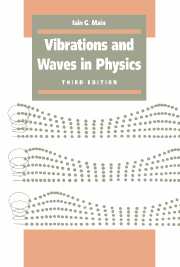Book contents
- Frontmatter
- Contents
- Preface to the first edition
- Preface to the second edition
- Preface to the third edition
- Notes for reference
- 1 Free vibrations
- 2 Free vibrations in physics
- 3 Damping
- 4 Damping in physics
- 5 Forced vibrations
- 6 Forced vibrations in physics
- 7 Anharmonic vibrations
- 8 Two-coordinate vibrations
- 9 Non-dispersive waves
- 10 Non-dispersive waves in physics
- 11 Fourier theory
- 12 Dispersion
- 13 Water waves
- 14 Electromagnetic waves
- 15 De Broglie waves
- 16 Solitary waves
- 17 Plane waves at boundaries
- 18 Diffraction
- Answers to problems and hints for solution
- Constants and units
- Index
8 - Two-coordinate vibrations
Published online by Cambridge University Press: 05 June 2012
- Frontmatter
- Contents
- Preface to the first edition
- Preface to the second edition
- Preface to the third edition
- Notes for reference
- 1 Free vibrations
- 2 Free vibrations in physics
- 3 Damping
- 4 Damping in physics
- 5 Forced vibrations
- 6 Forced vibrations in physics
- 7 Anharmonic vibrations
- 8 Two-coordinate vibrations
- 9 Non-dispersive waves
- 10 Non-dispersive waves in physics
- 11 Fourier theory
- 12 Dispersion
- 13 Water waves
- 14 Electromagnetic waves
- 15 De Broglie waves
- 16 Solitary waves
- 17 Plane waves at boundaries
- 18 Diffraction
- Answers to problems and hints for solution
- Constants and units
- Index
Summary
Systems which can be described in terms of a single coordinate are exceptional, and we must expect the vibrational possibilities to become more numerous and more complex as the required number of coordinates increases.
Most of the new features can be revealed by thinking about a system with only two coordinates. Even a two-coordinate system can exhibit very complicated vibrational behaviour, but we shall find that there are two very simple basic motions, known as modes, and that any other possible vibration can be treated as a superposition of these.
In the first two sections of this chapter we shall discover, without undue rigour, the physical nature of the modes and the way in which the mathematics can be simplified by the choice of a special coordinate system. The third section outlines the technique for finding these ‘mode coordinates’ for a given system, and the technique is applied to a physical example in section 8.4. Only sections 8.1 and 8.2 are strictly necessary to enable you to understand the rest of the book.
Modes and mode coordinates
We start with the simple system shown in fig. 8.1. It consists of two identical masses, connected to each other and to two fixed points by a symmetric arrangement of three springs, of which the outer ones each have stiffness s, and the central one has stiffness S. We ignore all forces other than the spring forces, and we consider one-dimensional motion of each mass along the line of the springs.
- Type
- Chapter
- Information
- Vibrations and Waves in Physics , pp. 112 - 140Publisher: Cambridge University PressPrint publication year: 1993



